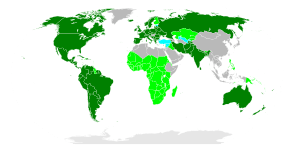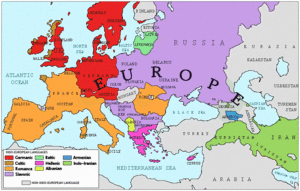Indo-European languages facts for kids
Quick facts for kids Indo-European |
|
|---|---|
| Geographic distribution: |
Before the 16th century, Europe, and South, Central and Southwest Asia; today worldwide. |
| Linguistic classification: | One of the world's major language families |
| Proto-language: | Proto-Indo-European |
| Subdivisions: |
Anatolian (extinct)
Tocharian (extinct)
|
| ISO 639-2 and 639-5: | ine |
 Countries with a majority of speakers of IE languages
Countries with an IE minority language with official status Countries where no Indo-European language is official, but a significant minority speak an Indo-European language |
|
The Indo-European languages are the world's largest language family. They include hundreds of related languages and dialects. These languages are spoken by more people than any other language family.
Experts called linguists believe all these languages came from one ancient language. This language is called Proto-Indo-European. It was likely spoken long ago in a region of Eurasia.
Today, Indo-European languages are spoken all over the world. They are the main languages in Europe, the Iranian plateau, and South Asia. In the past, they were also important in Anatolia and Central Asia.
The earliest writings in an Indo-European language are from the Bronze Age. These writings were in Greek in Anatolia and Mycenae. The original Proto-Indo-European language likely developed after farming began. This is because some words in Proto-Indo-European are about farming.
About 2.7 billion people speak an Indo-European language as their first language. This is more than any other language family. Out of the 20 languages with the most speakers, 12 are Indo-European. These include English, Spanish, Hindi, Portuguese, Bengali, Russian, German, Sindhi, Punjabi, Marathi, French, and Urdu.
Four of the six official languages of the United Nations are Indo-European. These are English, Spanish, French, and Russian.
Contents
Main Language Groups
The Indo-European language family has several main groups. Here are some of the most important ones:
- Albanian: Spoken mainly in Albania and Kosovo.
- Anatolian: These languages are now extinct. Examples include Luwian and Hittite.
- Armenian: Spoken mainly in Armenia.
- Balto-Slavic: This group includes two smaller families:
- Celtic: Such as Irish and Welsh.
- Germanic: This group includes many well-known languages like English, German, and Swedish.
- Greek: This includes both ancient Greek and modern Greek.
- Indo-Iranian: This is a very large group with two main branches:
- Indo-Aryan (also called Indic).
- Iranian.
- Latin and the Romance languages: This group includes Latin (an ancient language) and its modern descendants. Examples are French, Italian, and Romani.
Most Indo-European languages use the Latin alphabet. However, others use different writing systems. These include the Devanagari script (used for Hindi), the Cyrillic alphabet (used for Russian), or the Arabic alphabet (used for Urdu).
Indo-European Languages by Speakers
- Further information: List of countries by spoken languages, Lists of languages, and List of languages by number of native speakers
This table shows the number of native speakers for the main branches of Indo-European languages. The numbers are estimates from 2019.
| Number | Branch | Languages | Native Speakers | Main Writing Systems |
|---|---|---|---|---|
| 1 | Albanian language | 4 | 7,500,000 | Latin |
| 2 | Armenian language | 2 | 7,000,000 | Armenian |
| 3 | Balto-Slavic languages | 25 | 270,000,000 | Cyrillic, Latin |
| 4 | Celtic languages | 6 | 1,000,000 | Latin |
| 5 | Germanic languages | 47 | 550,000,000 | Latin |
| 6 | Hellenic languages | 6 | 15,000,000 | Greek |
| 7 | Indo-Iranian languages | 314 | 1,650,000,000 | Devanagari, Perso-Arabic |
| 8 | Italic languages | 44 | 800,000,000 | Latin |
| Total | Indo-European languages | 448 | 3,300,000,000 | – |
How We Learned About Indo-European Languages
People started noticing similarities between Indian and European languages a long time ago. In the 16th century, a missionary named Thomas Stephens in India saw these links. He wrote about them in a letter.
Later, in 1585, Filippo Sassetti, an Italian merchant, studied Sanskrit. He noticed similar words between Sanskrit and Italian. For example, sapta (Sanskrit) and sette (Italian) both mean "seven."
In 1647, a Dutch linguist named Marcus Zuerius van Boxhorn also saw these similarities. He thought these languages came from one common, older language. He included Dutch, Greek, Latin, Persian, and German in his idea. He later added Slavic, Celtic, and Baltic languages. However, his ideas did not become widely known at the time.
The idea became famous in 1786. Sir William Jones, a British scholar, gave a lecture. He talked about the strong similarities between Latin, Greek, and Sanskrit. He later added Gothic, Celtic, and Old Persian to this group.
In 1813, Thomas Young first used the term Indo-European. This term became the standard name for this language family. Franz Bopp's book, Comparative Grammar, published between 1833 and 1852, really started the study of Indo-European languages as a serious academic field.
For a long time, scholars debated where the Proto-Indo-European language began. Some thought it was in Armenia or India. Most now believe it started in Eastern Europe or Anatolia. Recent studies suggest a possible origin in northern Iran and Armenia.
Images for kids
See also
 In Spanish: Lenguas indoeuropeas para niños
In Spanish: Lenguas indoeuropeas para niños





